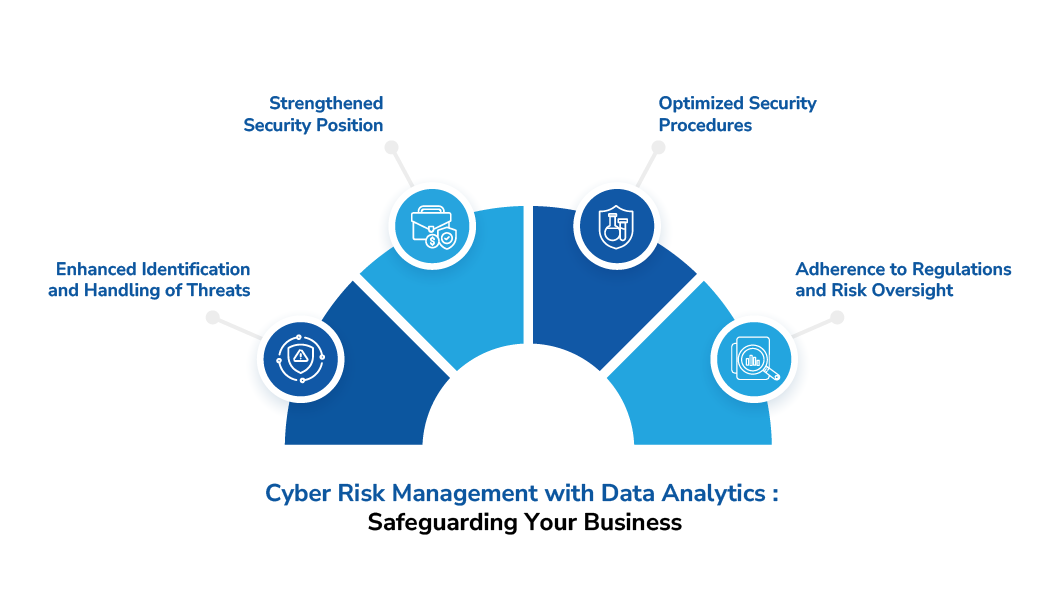Data analytics is transforming cyber risk management in the business world. Learn how data analytics, including AI and ML, is the key to staying ahead of disruptions and achieving resilience in the digital age.
The importance of quantifying cyber risk and making informed comparisons has never been more critical. As the realm of cyber risk management evolves, businesses increasingly rely on data analytics to safeguard their interests and ensure uninterrupted operations. As the old saying goes, "forewarned is forearmed," and in this age of data-driven decision-making, data analytics emerges as the game-changer.
A business disruption emerges when a multitude of factors converge, resulting in the temporary halt of business operations. These factors may encompass events such as cyberattacks, data breaches, system failures, or supply chain disruptions. These interruptions can trigger a cascade of consequences, from diminished productivity to severe financial losses.
Could the utilization of data analytics hold the key to mitigating these costly business interruptions?
As per McKinsey, there will be a 15% annual increase of costs related to cybercrime by 2025. Data analytics offers a promising solution for identifying the cyber risk factors associated with business interruptions. This proactive approach enables businesses to take preventative measures, potentially thwarting these interruptions before they disrupt operations. In doing so, not only does it help save resources that would have been spent on managing interruptions, but it also enhances the efficiency of post-interruption recovery efforts by providing crucial information regarding the extent of damage and the associated recovery costs.
The Power of Data Analytics in Cyber Risk Mitigation
- Data Analytics for Business Protection: The landscape of cyber risk management has undergone a profound transformation with the advent of data analytics. It now encompasses the safeguarding of your entire business ecosystem. In the modern business environment, companies face an array of challenges, from operational disruptions to economic uncertainties. Data analytics equips businesses with the power to proactively identify and mitigate these risks, providing real-time insights into various aspects of your business.
- Revealing Business Data Insights: Your organization generates a substantial volume of data on a daily basis, encompassing customer interactions, supply chain activities, and more. Data analytics harnesses this wealth of information to unveil concealed patterns, trends, and potential cyber risks. This isn't confined to retrospective analysis; it's about foresight – the ability to anticipate disruptions before they materialize.
Data analytics has evolved into data intensive cyber risk management, an invaluable resource for fortifying your business's defenses and navigating the complexities of the modern business landscape. By tapping into the wealth of data at your disposal, you gain a deeper understanding of your operations and enhance your ability to protect your business interests.
A Journey into Data-Driven Cyber Risk Management
- Preventing Repetitive Losses: From a cyber risk management standpoint, businesses leveraging data analytics and predictive models possess the capacity to anticipate and proactively mitigate recurrent losses. For instance, envision a situation where a company routinely confronts cyber vulnerabilities, leading to potentially costly breaches. Data analytics can unveil these recurring patterns, allowing for early detection and intervention, thereby averting significant financial and operational disruptions.
- Claims Management: Claims management services are integral to cyber risk mitigation. They allow you to monitor, prioritize, and resolve losses. These services play a crucial part in monitoring, prioritizing, and resolving cyber losses. Leveraging data analytics, businesses have the power to optimize this process through the automation of claim assessment and resolution. This proactive approach effectively curbs the escalation of losses, resulting in significant cost savings and an elevated level of customer satisfaction.
- Performance Monitoring: In the modern business landscape, operational efficiency is key. Data analytics has the capability to oversee a wide array of performance indicators, encompassing areas such as employee training, insurance claim statuses, system health, and the identification of physical threats. By guaranteeing the optimal functioning of these components, you seamlessly align your business objectives with the imperatives of cyber risk management, ensuring a robust and secure operational framework.
- Identifying Weaknesses: Within the realm of cyber risk management, every business possesses its own vulnerabilities, akin to an Achilles' heel, capable of triggering expensive interruptions. Data analytics serves as a focused lens, aiding in the precise identification of these weak points. These vulnerabilities might manifest as inadequacies in employee skills, operational cyber risks, financial susceptibilities, or deficiencies in cyber risk management procedures. Equipped with this knowledge, you can take proactive measures to address these issues before they escalate into significant business disruptions.
- Analyzing Customer Needs and Trends: In the context of cyber risk management, it's essential for businesses to remain attuned to the ever-evolving landscape of customer preferences and market trends, which are akin to constantly shifting sands. Data analytics, fueled by benchmarking and predictive modeling, emerges as a valuable ally in swiftly recognizing these fluctuations. Leveraging the capabilities of AI and machine learning, you gain the capacity to foresee factors like claim severity, litigation risks, and even potential business threats and interruptions, nipping them in the bud before they manifest.
Beyond Compliance: Navigating Towards Success
In the digital age, the significance of data analytics in cyber risk management cannot be overstated. It's the key to informed decision-making, helping organizations anticipate opportunities, predict outcomes, and proactively mitigate threats before they disrupt business operations. Cyber risk monitoring and analytics isn't merely a compliance obligation; it's the foundation of a resilient and prosperous business. While traditional cyber risk management methods have their place, relying on them alone in the digital era is like sailing through a storm without a compass.
Here are some key takeaways for businesses looking to harness data analytics for cyber risk management:
- Proactive Preparedness: Data analytics serves as a transformative catalyst, reshaping your strategy from a reactive stance to a proactive one. It equips you with essential instruments to foresee and brace for potential cyber risks and interruptions. Embracing proactive preparedness empowers you to not only mitigate the impact of adverse events but also to thwart potential disasters before they can materialize. This shift in approach, fueled by data-driven insights, fortifies your organization's resilience and minimizes vulnerabilities, ensuring that you are well-prepared to navigate the challenges of an ever-evolving business landscape while safeguarding your interests and preserving continuity.
- Efficient Resource Allocation: Leveraging data analytics for identifying weaknesses and opportunities becomes a strategic asset, enabling the optimized allocation of resources. A laser focus on areas in genuine need of improvement amplifies your Return on Investment (ROI), solidifying your competitive advantage. Through data-informed resource allocation, your organization not only operates more efficiently but also thrives in the dynamic business landscape, where precision and adaptability are key to sustained success. This data-driven approach ensures that your investments are channeled where they are most impactful, strengthening your position and fortifying your ability to excel in the competitive arena.
- Data-Driven Decision-Making: Informed decisions are the bedrock of business success. Data analytics furnishes the essential insights required to transform decisions from mere educated guesses into meticulously data-driven choices. This precision stands as the differentiator between flourishing and grappling in a fiercely competitive market. By embracing data-driven decision-making, organizations position themselves to not only navigate the complexities of the business landscape but also to excel, ensuring that their choices are finely tuned for success and adaptation to the ever-evolving demands of the market.
- Enhanced Customer Satisfaction: Comprehending the evolving needs and trends of your customer base empowers more effective and personalized engagement. Data analytics serves as the key to providing tailored solutions and experiences that resonate with your audience, ultimately fostering heightened customer satisfaction and unwavering loyalty. By harnessing these insights, businesses not only adapt to their customers' preferences but also forge deeper connections, securing their place as trusted and preferred providers in a competitive market. This customer-centric approach ensures that your offerings align closely with the desires of your audience, strengthening the bonds that drive enduring success and brand loyalty.
- Continuous Improvement: The dynamic nature of the business world demands continuous improvement. Data analytics, with its capability to monitor performance and pinpoint weaknesses, becomes the linchpin of an ongoing process aimed at refining your operations and cyber risk management strategies. This dynamic approach ensures that your organization remains agile and responsive to the shifting demands of the market. Through constant assessment and enhancement, driven by data-driven insights, you not only adapt to changing circumstances but also maintain a competitive edge. Data analytics propels a journey of continual refinement, strengthening your operations and Cyber risk mitigation, which is pivotal for success in today's fast-paced business environment.

Data Analytics for Business Resilience
Fully harnessing the transformative power of data analytics within cyber risk management and business intelligence insights necessitates a commitment to innovation. This journey is marked by several critical components:
- Investing in Technology: Embracing innovation commences with investing in cutting-edge analytics tools and technologies. These digital marvels possess the ability to swiftly process and analyze vast datasets in real-time. The result? Actionable insights and predictive capabilities that can serve as the bedrock of your cyber risk management strategy.
- Data Integration: An all-encompassing view of your operations and the broader business environment is a requisite for comprehensive cyber risk management. To achieve this, data integration is pivotal. It entails the harmonious convergence of data from diverse sources, both within your organization and from external avenues. This comprehensive data tapestry paints a clearer picture, enabling more informed decision-making and enhanced cyber risk assessment.
- Training and Skills: The knowledge and expertise to decipher, interpret, and act on data insights are the lifeblood of a data-driven cyber risk management strategy. Your team's proficiency in wielding these analytical tools is non-negotiable. Continuous training and upskilling are essential to keep your workforce at the cutting edge of data utilization, ensuring they are equipped to navigate the complexities of the modern business landscape.
- Agility: The rapidly evolving business landscape is the proving ground for companies looking to thrive. In this arena, agility is paramount. Data analytics empowers businesses with the agility to swiftly respond to both emerging cyber risks and opportunities. It provides the navigational tools needed to steer your organization through turbulent waters, adapting in real-time to seize opportunities and mitigate threats.
Embracing innovation in the context of data analytics for cyber risk management isn't just a choice; it's a strategic imperative. By investing in technology, integrating data, cultivating skills, and fostering agility, businesses can unlock new levels of resilience, competitive advantage, and long-term success.
Conclusion: Future of Cyber Risk Management
Across diverse industries, the future of cyber risk management is unmistakably anchored in data-driven security. In an age where businesses are increasingly data-centric, the role of analytics in mitigating cyber risks will undoubtedly continue to ascend. Furthermore, the integration of artificial intelligence and machine learning stands out as a pivotal advancement, significantly elevating the predictive capabilities of data analytics.
This transformative integration provides businesses with unparalleled predictive prowess, enabling them to anticipate customer demands, forecast market trends, and identify potential threats with remarkable precision. Not only does this foster resilient risk management, but it also unlocks new avenues for seizing emerging opportunities.
As businesses embark on this data-driven journey, they should bear in mind that innovation, adaptability, and the seamless integration of cutting-edge technologies are their greatest assets in maintaining a competitive edge. Thus, it is essential to wholeheartedly embrace the power of data analytics to secure and fortify the future of their business in the ever-evolving landscape of cyber risk management.



